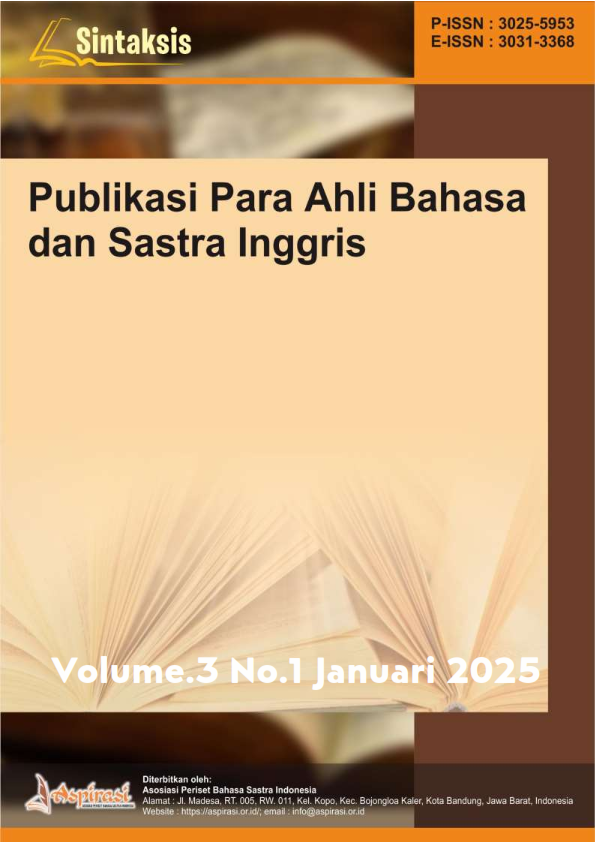A Systematic Review of Pragmatic Competence in Second Language Acquisition
DOI:
https://doi.org/10.61132/sintaksis.v3i1.1291Keywords:
Pragmatic competence, second language acquisition, intercultural communication, speech acts, politeness strategiesAbstract
This article presents a systematic review of pragmatic competence in second language acquisition (SLA), emphasizing its critical role in effective communication and intercultural understanding. Pragmatic competence encompasses the ability to understand and use language appropriately in diverse social and cultural contexts, including mastering speech acts, politeness strategies, conversational implicatures, and intercultural pragmatics. Despite its importance, pragmatic competence often receives less attention in language instruction compared to grammar and vocabulary. The review highlights the effectiveness of explicit and implicit teaching methods, authentic interaction, and cultural immersion in developing pragmatic skills. It also underscores the role of technology, such as digital platforms and simulations, in enhancing learners’ ability to navigate real-life communication scenarios.
The findings reveal significant challenges, including cultural variability in pragmatic norms, difficulties in standardizing assessments, and the influence of learners’ individual differences. The study calls for innovative teaching and evaluation methods, focusing on personalized approaches and the integration of pragmatic learning with emotional intelligence. By synthesizing current research and practices, this article provides valuable insights for educators, curriculum developers, and researchers, advocating for adaptive, culturally informed, and technology-supported strategies to enhance pragmatic competence in SLA.
Downloads
References
Bardovi-Harlig, K., & Dörnyei, Z. (1998). Do language learners recognize pragmatic violations? TESOL Quarterly, 32(2), 233–259. https://doi.org/10.2307/3587583
Blum-Kulka, S., & Olshtain, E. (1984). Requests and apologies: A cross-cultural study of speech act realization patterns (CCSARP). Applied Linguistics, 5(3), 196–213. https://doi.org/10.1093/applin/5.3.196
Brown, P., & Levinson, S. C. (1987). Politeness: Some universals in language usage. Cambridge University Press.
Cohen, A. D. (2008). Teaching and assessing L2 pragmatics: What can we expect from learners? Language Teaching, 41(2), 213–235. https://doi.org/10.1017/S0261444807004880
Grice, H. P. (1975). Logic and conversation. In P. Cole & J. L. Morgan (Eds.), Syntax and semantics, Vol. 3: Speech acts (pp. 41–58). Academic Press.
House, J. (2003). Teaching and learning pragmatic fluency in a foreign language: The case of English as a lingua franca. In G. Kasper & K. R. Rose (Eds.), Pragmatic development in a second language (pp. 133–158). Blackwell Publishing.
Kasper, G., & Rose, K. R. (2002). Pragmatic development in a second language. Blackwell Publishing.
Murphey, T. (1992). Music and song. Oxford University Press.
Rose, K. R., & Kasper, G. (2001). Pragmatics in language teaching. Cambridge Applied Linguistics Series. Cambridge University Press.
Taguchi, N. (2007). Development of speed and accuracy in pragmatic comprehension in English as a foreign language. TESOL Quarterly, 41(2), 313–338. https://doi.org/10.1002/j.1545-7249.2007.tb00059.x
Taguchi, N. (2011). The effect of L2 proficiency and study-abroad experience on pragmatic comprehension. Language Learning, 61(3), 904–939. https://doi.org/10.1111/j.1467-9922.2011.00633.x
Taguchi, N. (2015). Technology-enhanced materials for pragmatic development. In C. A. Chapelle (Ed.), The encyclopedia of applied linguistics (pp. 1–8). Wiley. https://doi.org/10.1002/9781405198431
Downloads
Published
How to Cite
Issue
Section
License
Copyright (c) 2024 Sintaksis : Publikasi Para ahli Bahasa dan Sastra Inggris

This work is licensed under a Creative Commons Attribution-ShareAlike 4.0 International License.





